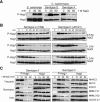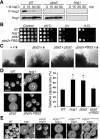Specialization of the HOG pathway and its impact on differentiation and virulence of Cryptococcus neoformans
- PMID: 15728721
- PMCID: PMC1087235
- DOI: 10.1091/mbc.e04-11-0987
Specialization of the HOG pathway and its impact on differentiation and virulence of Cryptococcus neoformans
Abstract
The human pathogenic fungus Cryptococcus neoformans has diverged from a common ancestor into three biologically distinct varieties or sibling species over the past 10-40 million years. During evolution of these divergent forms, serotype A C. neoformans var. grubii has emerged as the most virulent and cosmopolitan pathogenic clade. Therefore, understanding how serotype A C. neoformans is distinguished from less successful pathogenic serotypes will provide insights into the evolution of fungal virulence. Here we report that the structurally conserved Pbs2-Hog1 MAP kinase cascade has been specifically recruited as a global regulator to control morphological differentiation and virulence factors in the highly virulent serotype A H99 clinical isolate, but not in the laboratory-generated and less virulent serotype D strain JEC21. The mechanisms of Hog1 regulation are strikingly different between the two strains, and the phosphorylation kinetics and localization pattern of Hog1 are opposite in H99 compared with JEC21 and other yeasts. The unique Hog1 regulatory pattern observed in the H99 clinical isolate is widespread in serotype A strains and is also present in some clinical serotype D isolates. Serotype A hog1delta and pbs2delta mutants are attenuated in virulence, further underscoring the role of the Pbs2-Hog1 MAPK cascade in the pathogenesis of cryptococcosis.
Figures











References
-
- Alepuz, P. M., Jovanovic, A., Reiser, V., and Ammerer, G. (2001). Stress-induced map kinase Hog1 is part of transcription activation complexes. Mol. Cell 7, 767–777. - PubMed
-
- Alonso-Monge, R., Real, E., Wojda, I., Bebelman, J. P., Mager, W. H., and Siderius, M. (2001). Hyperosmotic stress response and regulation of cell wall integrity in Saccharomyces cerevisiae share common functional aspects. Mol. Microbiol. 41, 717–730. - PubMed
-
- Alspaugh, J. A., Pukkila-Worley, R., Harashima, T., Cavallo, L. M., Funnell, D., Cox, G. M., Perfect, J. R., Kronstad, J. W., and Heitman, J. (2002). Adenylyl cyclase functions downstream of the Gα protein Gpa1 and controls mating and pathogenicity of Cryptococcus neoformans. Eukaryot. Cell 1, 75–84. - PMC - PubMed
Publication types
MeSH terms
Substances
Grants and funding
LinkOut - more resources
Full Text Sources
Miscellaneous

